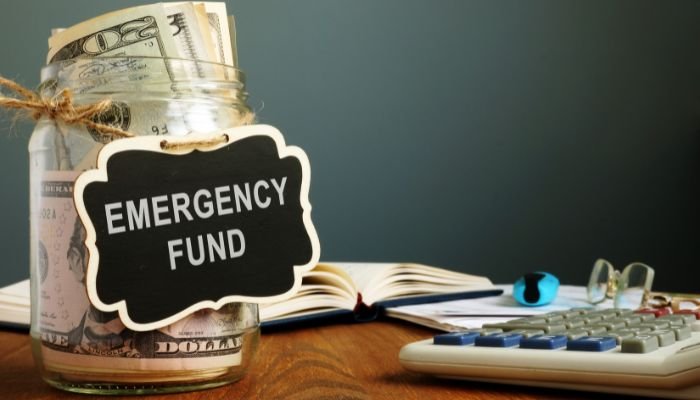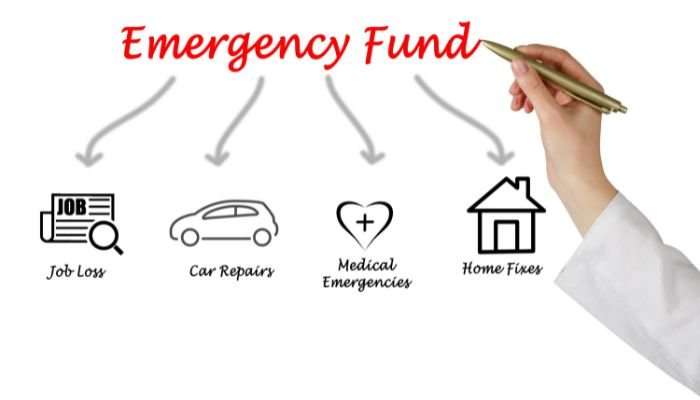Disclaimer: This post may contain affiliate links, meaning we get a small commission if you make a purchase through our link at no extra cost to you. For more information, please visit our Disclaimer Page.
I’m not a financial advisor, I just do research and share that to you my readers so that you can get value. If you want more thorough and customized advice, please consult a financial advisor.
Are you wondering how to prepare for financial emergency as a millennial?
Life is full of surprises, and not all of them are good.
Emergencies can happen when you least expect them—whether it’s a sudden job loss, unexpected medical bills, or a major home repair. That’s why it’s essential to be prepared financially, especially as a millennial.
In this blog post, I’ll walk you through practical strategies to create a financial safety net that can help you handle those unexpected challenges with confidence.
From building an emergency fund to understanding your spending habits and exploring insurance options, these steps will help you weather any financial storm that comes your way.
Say goodbye to sleepless nights worrying about what could go wrong. Now’s the time to take control and start building your path toward financial peace of mind!
Step 1: Understand What Constitutes a Financial Emergency
Before you can prepare, it’s crucial to understand what qualifies as a financial emergency.
Emergencies are unplanned events that require immediate attention and often involve significant expenses.
It’s important to distinguish between genuine emergencies and ordinary financial needs to ensure you’re using your resources effectively.
A financial emergency has these key characteristics:
- Unplanned: It’s an unexpected event that you couldn’t have anticipated in your regular budget.
- Critical: It requires immediate attention and cannot be delayed.
- Vital: It’s essential to your well-being—whether it impacts your health, livelihood, or basic needs.
- Costly: The cost is large enough that it could affect other areas of your financial situation if not addressed promptly.
Examples of financial emergencies include medical bills from an accident, home repairs due to a natural disaster, or a sudden job loss that requires an immediate shift in your finances.
Now, to make it easier for you to understand what constitutes a financial emergency, let’s have a comparison table:
| Financial Emergency | Not a Financial Emergency |
|---|---|
| Sudden job loss | Upgrading your smartphone |
| Medical emergencies | Planned cosmetic procedures |
| Essential home repairs (e.g., broken heating) | Home renovations for aesthetics |
| Car repairs necessary for commuting | Buying a new car for style |
| Unexpected tax bills | Annual property taxes |
| Emergency travel for family crisis | Vacation expenses |
Common Financial Emergencies Millennials May Encounter
As a millennial, you’re likely to face a variety of financial emergencies throughout your life.
Recognizing potential pitfalls allows you to prepare in advance and respond effectively when they occur. Here are some common financial emergencies you may encounter:
- Job Loss or Income Reduction: In today’s unpredictable job market, layoffs and income reductions can happen without warning. Additionally, many millennials work in the gig economy or on contract, where income volatility is common.
- Medical Emergencies: Even young and healthy individuals can face sudden illness or injury. High deductibles and out-of-pocket maximums in health insurance plans can lead to unexpectedly high medical costs.
- Major Car Repairs: If your car is essential for work or daily life, a breakdown can be both inconvenient and expensive.
- Necessary Home Repairs: Homeowners and renters alike can face unexpected expenses like plumbing issues, HVAC breakdowns, or roof leaks—each of which can cost thousands of dollars to repair.
- Surprise Tax Bills: Mistakes in tax withholdings or changes in tax laws can lead to owing more at tax time than you expected.
- Family Emergencies: A sudden illness or death in the family can require you to make unplanned travel arrangements or provide financial support to loved ones.
- Natural Disasters: If you live in an area prone to hurricanes, floods, or earthquakes, it’s crucial to have a financial plan in place for such events.
- Legal Issues: Unexpected legal issues, such as lawsuits or needing legal representation, can drain your finances quickly.
- Tech Failures: In today’s digital world, a critical piece of tech, like your work laptop, breaking down unexpectedly can qualify as a financial emergency.
- Pet Emergencies: Many millennials consider pets part of the family. Unforeseen veterinary bills can be a major financial burden.
By recognizing these potential emergencies, you can take proactive steps to prepare and protect yourself financially.
To illustrate the importance of preparation, let’s look at a scenario comparison:
| Prepared for Emergency | Unprepared for Emergency |
|---|---|
| Can cover expenses from savings | Forced to use high-interest credit cards |
| Maintains financial stability | May fall into debt cycle |
| Focuses on solving the problem | Stressed about finances and the problem |
| Recovers quickly | May take months or years to recover |
| Protects long-term financial goals | May need to postpone or abandon financial goals |
| Maintains quality of life | Might need to make significant lifestyle changes |
| Has options for addressing the emergency | Limited in choices due to financial constraints |
| Credit score remains intact | Risks damaging credit score |
| Can make rational decisions | May make hasty, suboptimal decisions |
| Potentially able to help others | Might need to rely on others for help |
As you can see, being prepared for financial emergencies offers numerous benefits and can significantly impact your overall financial health and life quality.
How To Prepare For Financial Emergency
Build an Emergency Fund
As a millennial, building an emergency fund is an essential step in preparing for financial emergencies.
Now that you understand what constitutes a financial emergency, let’s look at how to prepare for one.
1. Set a Realistic Savings Goal
Setting a realistic savings goal is the foundation of building your emergency fund.
As a millennial, you may face unique financial challenges, earning a small income but don’t let that stop you from establishing a solid financial cushion.
Determine Your Target Amount
Financial experts typically recommend saving 3 to 6 months’ worth of living expenses. However, your situation may require more or less. Consider these factors when setting your target amount:
- Job stability
- Income volatility
- Family responsibilities
- Health conditions
- Existing debts
For example, if you work in a volatile industry or have dependents, you may want to aim for 6 to 9 months of expenses. On the other hand, if you have a stable job and fewer financial obligations, 3 to 4 months may suffice.
Break It Down into Smaller Milestones
Once you’ve determined your target amount, break it down into smaller, more manageable milestones.
This approach makes the goal less daunting and helps you stay motivated.
Here’s how you can structure your milestones:
| Milestone | Target Amount | Timeframe |
|---|---|---|
| 1 | $1,000 | 3 months |
| 2 | $2,500 | 6 months |
| 3 | $5,000 | 1 year |
| 4 | $10,000 | 2 years |
Tailor the Numbers and Timelines
These are only examples. Tailor the numbers and timelines to your unique financial situation and aspirations.
Celebrate Your Progress
Take a moment to celebrate your success after reaching each milestone.
This reward will help keep you encouraged and focused on your long-term objective.
You could give yourself a small incentive or share your progress with friends and family who are also tracking your financial journey.
Calculate How Much to Save Each Month
Now that you’ve established your savings goal, you need to determine how much to set aside each month to hit that target.
This requires a detailed review of your income and expenses.
Evaluate Your Current Financial Picture
Create a budget that lists all of your income and expenses. This will give you a clear picture of your financial health and highlight areas where you can cut back or shift funds toward your emergency savings.
Calculate Your Savings Rate
To find out how much you need to save each month, here’s a simple formula:
Monthly Savings Target = Total Emergency Fund Goal / Number of Months to Reach Goal
For example, if your goal is to save $10,000 in two years, your calculation would look like this:
Monthly Savings Target = $10,000 / 24 months = $416.67 per month
Revisit Your Budget and Find Room to Save
If you need to figure out how much you need to save each month, review your budget and identify areas where you can adjust.
Here are some ways to free up cash for your emergency fund:
- Eliminate Upfront Costs: Look for subscriptions or services you rarely use and cancel them.
- Cut Discretionary Spending: Reduce spending on dining out, entertainment, and shopping.
- Negotiate Bills: Contact your service providers to inquire about potential lower rates on utilities, insurance, or phone plans.
- Boost Your Income: Consider picking up a side hustle or asking for a raise at work.
The goal is to strike a balance between saving for emergencies and maintaining a good quality of life.
Set realistic goals and don’t expect to change everything overnight or ignore disruptions without impacting your daily life.
Pick the Best Savings Account
Choosing the right savings account for your emergency fund is essential.
You need an account that offers easy access to your money, but ideally one with a high enough interest rate to help your savings grow over time.
High-Yield Savings Accounts
Millennials, you might want to consider a high-yield savings account for your emergency fund.
Interest rates on high-yield savings accounts are often much higher than those of traditional savings accounts, meaning you’ll earn more interest on your money.
Here are some pros of high-yield savings accounts:
- High-interest rates (10 to 25 times higher than traditional savings accounts)
- FDIC insurance protection
- Easy access to your funds
- Low or no minimum balance requirements
- Mobile and online banking availability
Compare Account Features
If you’re going to choose a savings account for your emergency fund, consider the following factors:
| Feature | What to Look For |
|---|---|
| Interest Rate | Highest Annual Percentage Yield (APY) available |
| Fees | No monthly maintenance fees or low balance fees |
| Minimum Balance | Low or no minimum balance requirement |
| Accessibility | Easy withdrawals and transfers |
| Insurance | FDIC or NCUA insured |
| Additional Features | Mobile app, bill pay, ATM access |
Comparing Online Banks and Traditional Banks
Online Banks for Emergency Funds
As a tech-savvy millennial, you may find that online banks offer better interest rates and features for your emergency fund.
Online banks typically have lower overhead costs, allowing them to pass those savings on to customers through higher interest rates and lower fees.
Traditional Banks
On the other hand, traditional banks might offer in-person customer service and a larger ATM network.
The final decision between online and traditional banks comes down to your personal preferences.
Automate Your Savings
One of the most effective ways to ensure consistent emergency fund growth is to automate your savings.
Automating transfers removes the temptation to use that money for other purposes and guarantees that you consistently move toward your goal.
Set Up Automatic Transfers
Most banks allow you to schedule recurring transfers from your checking account to your savings account. Here’s how to do it:
- Decide how much to transfer based on your monthly savings target.
- Select a transfer frequency (weekly, biweekly, or monthly).
- Log into your online banking platform or mobile app.
- Go to Automatic Transfer or Recurring Transfer options.
- Arrange for the transfer to come from your checking account to your emergency fund savings account.
- Choose the start and end dates (if applicable).
- Verify the transfer details.
Tip:
Schedule your automatic transfer for the same day you get paid. This way, you’re “paying yourself first” before you have the chance to spend the money on other things.
Use Round-Up Savings Apps
In addition to automatic transfers, round-up savings apps can help you grow your emergency fund.
These apps round up your purchases to the nearest dollar and move the difference into your savings account.
Some popular round-up savings apps include:
While the amounts may seem small, these micro-savings can add up quickly over time, giving your emergency fund an extra boost.
Review and Adjust Your Automation Regularly
It’s important to regularly review and adjust your automated savings plan as your finances change.
Set a reminder to review your progress every few months and make adjustments if necessary.
For example, consider increasing your savings rate in the following situations:
- You receive a raise or bonus at work.
- You pay down a liability, freeing up additional cash.
- You cut back on spending in other areas.
By reviewing and optimizing your automated savings plan regularly, you can continue to make the most of your income and stay on track to reach your emergency fund goals.
Preparing for a Financial Emergency
Preparing for a financial emergency may seem challenging, but it’s one of the most important aspects of life that requires your attention.
That’s why I’m guiding you through the steps involved in it.
Acknowledging Life Events
Sometimes, life events can disrupt your financial planning. I’ve experienced this myself while searching for money to fix things, and life events got in the way of my plans.
Conclusion
Unexpected costs don’t have to derail your financial stability. The smartest move is to prepare for a financial emergency before a crisis strikes.
Setting up an emergency fund, cutting unnecessary expenses, and securing additional income sources can provide the cushion you need.
Even small savings add up over time, giving you peace of mind and freedom from financial stress.
While no one can predict the future, being ready for anything puts you in control.
Start with simple, consistent actions: budget wisely, build savings, and explore new income streams.
Every step forward counts. Take charge of your finances today and create a future where money troubles won’t hold you back.





